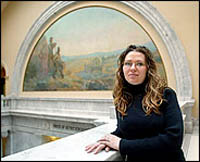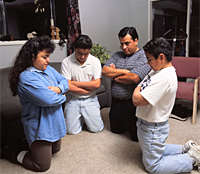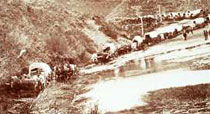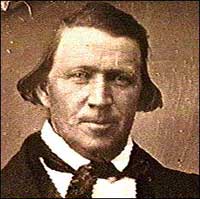| (insert your NIE or newspaper logo here) |
Weekly Online LessonOnline Lesson ArchiveGrade Level: 7-12
|
The State of Mormonism
 Last
week the state of Utah arrested alleged polygamist Jeremy Kingston,
a member of the region's large and powerful Kingston clan. On Thursday,
July 24, 2003, he was charged not with polygamy, however, but with incest
stemming from his 1995 arranged marriage to his first cousin LuAnn Kingston.
At the time, she was 15 and he was 24.
Last
week the state of Utah arrested alleged polygamist Jeremy Kingston,
a member of the region's large and powerful Kingston clan. On Thursday,
July 24, 2003, he was charged not with polygamy, however, but with incest
stemming from his 1995 arranged marriage to his first cousin LuAnn Kingston.
At the time, she was 15 and he was 24.
Ironically, Mr. Kingston was tracked down at a huge family gathering of his extended family celebrating Pioneer Day, which commemorates the arrival of Mormon settlers in the Salt Lake Valley on July 24, 1847. The pioneers brought polygamy with them, but when residents sought statehood in the late 1800s, the Mormon Church, formally known as the Church of Jesus Christ of Latter-day Saints (LDS), renounced the practice.
Today, the LDS Church excommunicates members who practice or preach polygamy. Despite that, an estimated 30,000 to 50,000 polygamists who have separated from the mainstream Mormon religion live in Utah and other parts of the southwest, Mexico and Canada.
LuAnn Kingston has said that Jeremy Kingston had three wives and 17 children when he married her. She left the marriage after five years and in May asked the state to prosecute Mr. Kingston. The accounts of Ms. Kingston—who has testified publicly—and other young women have prompted Utah, after years of ambivalence, to take a tough new look at polygamists who marry teenagers.
 The
LDS Church has grown from six members in 1830 to over 11 million
across 160 countries. Over 5 million live in the United States. Utah
is the heartland of Mormonism, with over two-thirds of its 2.4 million
residents belonging to the Church.
The
LDS Church has grown from six members in 1830 to over 11 million
across 160 countries. Over 5 million live in the United States. Utah
is the heartland of Mormonism, with over two-thirds of its 2.4 million
residents belonging to the Church.
This strong majority in the state is no coincidence. An early goal of the Church was to establish an LDS-run state that would eventually become part of the United States. Today, the Mormon Church wields powerful influence over business, politics, family life and other aspects of this state's communities and interrelationships.
For this week's lesson, you'll learn about the history and principles of Mormonism and how the religion and its followers have shaped Utah's identity. You'll also follow the Mormon Trail and discover how these emigrants first arrived in the Great Basin, and how they helped others of their faith populate the region.
History and Beliefs
 Begin
learning about this American-born religion at BBC's Religion & Ethics
site on Mormonism.
Read the Introduction
and review the additional statistics.
Which continent boasts the second largest membership?
Begin
learning about this American-born religion at BBC's Religion & Ethics
site on Mormonism.
Read the Introduction
and review the additional statistics.
Which continent boasts the second largest membership?
Next browse through the History of Mormonism from the Beginnings, to Joseph Smith, to the Pioneers, to Utah, to Statehood, and Modern Times.
How did the Book of Mormon come into existence? For what reasons were the Mormons persecuted? Where was the first Mormon Temple built? Why did Brigham Young lead his congregation to the western territories? What's the significance of the name "Deseret"? In what ways did federal law affect the Church?
 Obviously,
people have been intensely passionate for or against Mormonism over
the years. So what's so attractive, and simultaneously controversial,
about this religion? To find out, explore the sections on God,
Life and Afterlife, Beliefs,
Worship,
Customs, and Ethics.
Obviously,
people have been intensely passionate for or against Mormonism over
the years. So what's so attractive, and simultaneously controversial,
about this religion? To find out, explore the sections on God,
Life and Afterlife, Beliefs,
Worship,
Customs, and Ethics.
Also read a few of the Features at the site, including Are Mormons Christians?, Mormons and Other Faiths, Polygamy, and Death.
Why are marriage and children critical to the Mormon faith? What is the relationship between humans and God? How does that compare to the views of other religions, including other branches of Christianity? What's the purpose of baptizing the deceased? Why exactly did Mormons practice polygamy? In what ways do Mormons' beliefs shape their lives — as individuals, families, communities and regional societies?
Establishing Zion
 The
promise of a land where Mormons could live freely as their religion
dictated, without persecution from others, was the driving force behind
the mass migration to the American West. And although they were passionate
about their beliefs and goals, these pioneers had a tough road to travel.
The
promise of a land where Mormons could live freely as their religion
dictated, without persecution from others, was the driving force behind
the mass migration to the American West. And although they were passionate
about their beliefs and goals, these pioneers had a tough road to travel.
Take a trip on the Mormon Trail — from Illinois to the Great Salt Lake Basin — to get a taste of The Pioneer Story, presented by the LDS Church. Start the trail from the beginning in Nauvoo, and move along the route by clicking the button labeled Next Location West on the Pioneer Trail Map.
As you follow the trail, you'll read about the handcarts and the Perpetual
Emigrating Fund in Iowa
City and the Mormon Battalion in Council
Bluffs. Continue west, and you'll discover why the Mormon
Trail was forged along the north side of the Platte
River.
At Chimney
Rock and the North
Platte River, you'll discover how these first Mormon migrants
paved the way for others who would follow.
 In
their journals, migrants describe some of the journey's worst suffering
at Devil's
Gate. During the last leg of the route, you'll pass through
Emigration
Canyon, then, once over the treacherous pass, you'll drop
into the Great
Salt Lake Valley.
In
their journals, migrants describe some of the journey's worst suffering
at Devil's
Gate. During the last leg of the route, you'll pass through
Emigration
Canyon, then, once over the treacherous pass, you'll drop
into the Great
Salt Lake Valley.
In what ways did Brigham Young, and the group's religious principles, make the Mormons' trek to the West different than what the majority of non-Mormon pioneers experienced? How did the Mormon settlements around the Great Salt Lake compare to other settlements in the West that were not based on a common, religion-based vision?
Continue a bit farther in time at Utah History To Go to see how this region developed beyond the initial settlement. From the Pioneers & Cowboys section, read about Settlement and Exploration, Colonization of Utah, and the settlement of Salt Lake City.
Also visit the Statehood & Progressive Era section, and read about the territory's Struggle for Statehood and Change and Creativity. Your last stop brings you to Utah Today, where the article titled The New Polygamy explains how the LDS Church, Mormon fundamentalists and the government have struggled over this contentious issue.
What do you think about the federal government's attempts to control religious-based lifestyles? What is the relationship between church and state in Utah? For example, do you think there is or isn't any evidence that the LDS Church influences the Utah government's position on certain issues or policies?
How do you think media coverage of polygamy cases, such as that of Jeremy Kingston, could pressure Utah — and possibly other states — to create new legislation to protect teenage girls from abuse and to enforce laws already on the books? To what degree and in what ways do you think that the views, beliefs or politics of Americans who live elsewhere should have a hand in shaping local and regional communities?
Newspaper Activities
Check out current issues of Targetnewspaper to find stories about polygamy or Mormonism. If the articles are related to polygamy, do they demonstrate that Utah is, indeed, cracking down on abusive polygamists? How are fundamentalist Mormons reacting to these events? If the stories relate to Mormonism in other ways, what exactly is the news peg? Are Mormon principles clashing with non-Mormon views over political, business or cultural decisions? Or, are people finding common ground to help resolve an issue despite their different viewpoints or religious beliefs?
Also review the newspaper's weekly religion section, if it publishes one, to see what types of religions are being written about the most. Does the coverage accurately reflect your community's religious sects? If the paper provides a directory of places of worship, count how many exist for each type of religion. Is there a lot of spiritual diversity or is one religious belief system clearly dominant? Do you think your community's religious composition influences your local government at all? Why or why not?
© Copyright 2003
Learners Online, Inc.
